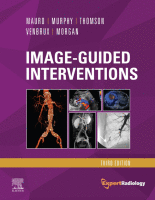Physical Address
304 North Cardinal St.
Dorchester Center, MA 02124

Principles of Focused Ultrasound Imaging High-intensity focused ultrasound (HIFU) is a noninvasive thermoablative therapeutic technique that utilizes focused ultrasound beams to target and thermally heat tissue. First introduced in 1942, ultrasound-induced thermal coagulative necrosis has been studied for over 60…

In 2019, it is estimated that there will be more than 73,000 new cases and 14,770 deaths from renal cancer (including renal pelvis) in the United States. Renal parenchymal tumors (i.e., renal cell carcinoma [RCC]) account for most (85%) kidney…

Percutaneous nephrostomy (PCN) was first described by Goodwin in 1955 when a hydronephrotic kidney was accessed using a trocar needle during fluoroscopy. PCN is now widely used as the basis for a variety of therapeutic procedures ranging from simple urinary…

Liver lesions have a wide spectrum of presentation, from an incidentally discovered and asymptomatic simple liver cyst to multifocal primary or metastatic liver tumors. The interventions used to treat this wide range of lesions are equally as varied, and percutaneous…

Indications Cryoablation can be used to treat primary malignant liver lesions such as hepatocellular carcinoma (HCC), as well as benign lesions such as symptomatic hemangiomas and liver adenomas. Nonetheless, the most common use of cryoablation in the liver in the…

Thermal ablation includes several different energy-based therapeutic modalities, all united in exposing tumoral lesions to cytotoxic temperatures, with consequent induction of cell death while preserving normal liver parenchyma. These features have promoted their widespread use in the management of liver…

Acknowledgments The authors wish to acknowledge authors Daniel B. Brown and Daniel D. Picus for their contribution to this chapter in the second edition of this textbook. Clinical Relevance Gallstones affect more than 10% to 15% of the US population.…

Clinical Relevance Acute cholecystitis (AC) is a prevalent condition that carries significant risks of morbidity and mortality. AC may present with a spectrum of disease stages ranging from a mild self-limited illness to a fulminant potentially life-threatening illness. The 2018…

Biliary leakage is defined as diversion of bile via a defect in the ductal wall leading to the formation of bilomas, fistulas, or free spillage into the peritoneal cavity. It is a common complication after liver and biliary surgery. With…

Management of benign biliary strictures, whether surgical, percutaneous-transhepatic, or by endoscopic means, is difficult. These lesions are formed of cicatricial fibrosis and are recalcitrant to many minimally invasive techniques. They can be a contributing factor to recurrent cholangitis, hepatic segmental…